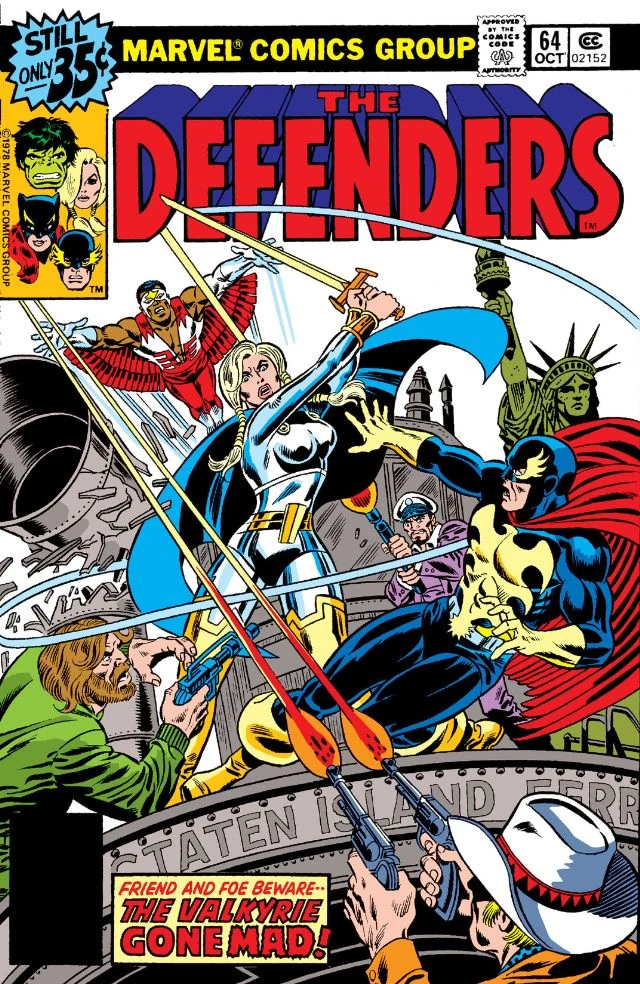In the ever-expanding universe of comic books, the concept of superhero teams has thrived since 1940, giving rise to iconic franchises. In this exploration of the top 10 superhero teams, we delve into the origins, evolution, and cultural impact of each ensemble. From street-level defenders to galaxy-hopping teens, the list encompasses the crème de la crème of superhero collaborations.
10. The Defenders: Unlikely Allies Against Cosmic Threats
Marvel’s Defenders, often overshadowed by their more illustrious counterparts, emerged as a formidable force from 1972 to 1985. Comprising loner heroes like Namor, Doctor Strange, the Hulk, and Silver Surfer, the Defenders tackled world-ending threats beyond the reach of traditional superheroes. Their non-team status, lacking formal structure or headquarters, added a dynamic twist to their crime-fighting endeavors. With a rich roster that expanded to include characters like Valkyrie, the Defenders remain an iconic team worthy of a resurgence, perhaps even a debut in the Marvel Cinematic Universe.
9. The Doom Patrol: Eccentric Outcasts and Surreal Adventures
DC’s Doom Patrol, predating the X-Men, debuted in 1963 as a group of misfits led by a genius in a wheelchair. After a hiatus, the team experienced a revival in 1989, thanks to writer Grant Morrison’s surreal and psychedelic take. The revamped Doom Patrol, more a support group for super-powered misfits than traditional superheroes, captured readers’ imaginations. This unique approach inspired a Max streaming series, solidifying the Doom Patrol’s status as one of the most intriguing and unconventional superhero teams.
8. The Justice Society of America: Pioneers of Superhero Team-Ups
The Justice Society of America, created by DC in 1940, laid the foundation for superhero team-ups. Featuring DC’s main heroes, excluding Superman and Batman, the JSA showcased characters like the Flash, Green Lantern, and Wonder Woman. Though the JSA faded after World War II, it found renewed relevance in the early 2000s with a legacy-focused series. The JSA’s enduring legacy and modern-day roster affirm their status as trailblazers in the realm of superhero teams.
7. The Legion of Super-Heroes: Galactic Teens from the Future
Once a major seller for DC in the ’70s and ’80s, the Legion of Super-Heroes comprised super-powered teens from the future. Debuting in 1958, the Legion’s popularity surged, boasting a roster that expanded to 25 members. The series’ teenage superhero soap opera, driven by writers like Paul Levitz, resonated with readers and contributed to the Legion’s status as one of the greatest super teams, despite facing challenges from frequent reboots.
6. The Teen Titans: Sidekicks Turned Icons
Born out of a need for a Justice League spinoff, the Teen Titans emerged in 1965 as a light-hearted team of teen sidekicks. However, it was the 1980s revival, spearheaded by Marv Wolfman and George Perez in the New Teen Titans, that elevated the team to new heights. Introducing fresh characters like Cyborg, Starfire, and Raven, the revamped Teen Titans became DC’s biggest hit of the decade. Subsequent revivals, including Geoff Johns’ 2003 series, and multimedia adaptations, solidified the Teen Titans as enduring and cool superhero icons.
5. The Teenage Mutant Ninja Turtles: Independent Icons with Enduring Appeal
Defying the Marvel-DC duopoly, the Teenage Mutant Ninja Turtles burst onto the scene as independent icons in 1984. Conceived as a parody, the “Heroes in a Half-shell” became a cultural phenomenon, transcending their comic book origins. The turtles’ enduring popularity is marked by animated series, live-action movies, and a recent animated film, affirming their status as the most successful independent comic book superhero team.
4. The Fantastic Four: Marvel’s First Family Redefining Superhero Dynamics
Marvel’s response to the success of DC’s Justice League, the Fantastic Four, debuted in 1961 with a fresh approach—superheroes as a dysfunctional family. Created by Stan Lee and Jack Kirby, the FF’s dynamic personalities and cosmic adventures shaped the Marvel Universe. Their influence extends to iconic characters like the Ninja Turtles and Pixar’s Incredibles, solidifying the Fantastic Four as one of comics’ most famous and influential teams.
3. The Avengers: Earth’s Mightiest Heroes’ Rise to Prominence
Initially overshadowed by DC’s Justice League, the Avengers became Marvel’s “All-Star” team in 1963. Stan Lee and Jack Kirby’s creation evolved, incorporating former villains like Hawkeye and Black Widow into prominent roles. Despite lagging behind in original sales, the Avengers’ meteoric rise in the 21st century, propelled by the Marvel Cinematic Universe, established them as premier sports teams with the best players in the right positions.
2. The X-Men: A Mutant Saga Redefining Superhero Storytelling
The X-Men, born in 1963, perfected the ongoing soap opera formula in superhero comics under writer Chris Claremont. Distinguished by racial and national diversity, the X-Men’s central metaphor of prejudice and alienation set them apart. The team’s profound impact resonated with readers on a deeper level, making them a cultural touchstone. From the ’90s animated series to blockbuster films, the X-Men’s journey from slow sales to superstardom transformed them into comic book icons.
1. The Justice League: Icons Led by Superman, Batman, and Wonder Woman
Securing the top spot is the Justice League, comprising three of the most iconic superheroes—Superman, Batman, and Wonder Woman. Debuting in 1960, the Justice League’s success spurred the return of superheroes in rival Marvel Comics. Their status as an All-Star team, featuring DC’s trinity in leading roles, solidified their place as the greatest superhero team. From comic book pages to Saturday morning cartoons, the Justice League remains the blueprint for superhero team success in other media.
In conclusion, the rich history and diverse characteristics of these superhero teams have left an indelible mark on comic book culture, influencing generations of readers and transcending the boundaries of their sequential art origins.


